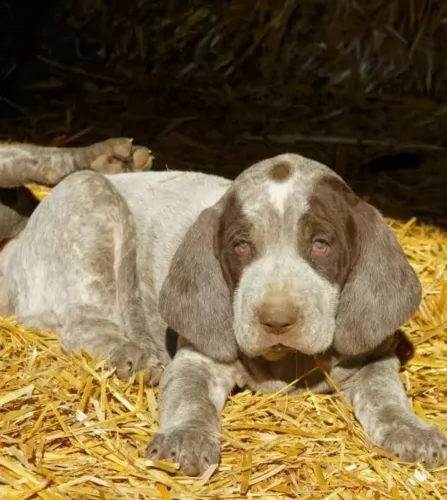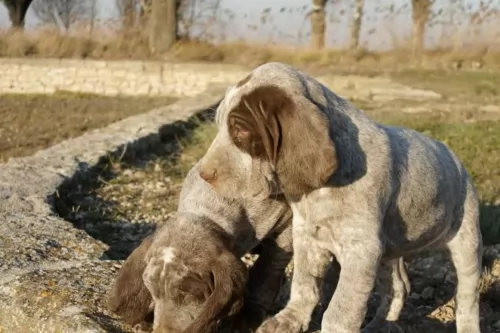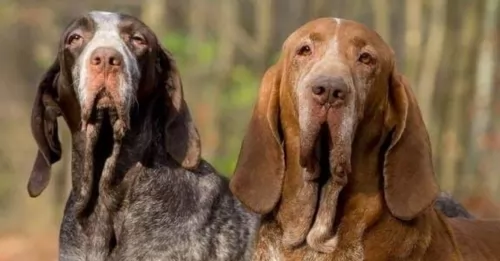 MyDogBreeds
MyDogBreeds Perdiguero de Burgos is originated from Spain but Bulgarian Shepherd is originated from Bulgaria. Perdiguero de Burgos may grow 11 cm / 4 inches shorter than Bulgarian Shepherd. Perdiguero de Burgos may weigh 25 kg / 55 pounds lesser than Bulgarian Shepherd. Perdiguero de Burgos may live 43 years less than Bulgarian Shepherd. Both Perdiguero de Burgos and Bulgarian Shepherd has same litter size. Perdiguero de Burgos requires Low maintenance. But Bulgarian Shepherd requires Moderate maintenance
Perdiguero de Burgos is originated from Spain but Bulgarian Shepherd is originated from Bulgaria. Perdiguero de Burgos may grow 11 cm / 4 inches shorter than Bulgarian Shepherd. Perdiguero de Burgos may weigh 25 kg / 55 pounds lesser than Bulgarian Shepherd. Perdiguero de Burgos may live 43 years less than Bulgarian Shepherd. Both Perdiguero de Burgos and Bulgarian Shepherd has same litter size. Perdiguero de Burgos requires Low maintenance. But Bulgarian Shepherd requires Moderate maintenance
 The Iberian Peninsula is thought to be the place of origin for many of the pointing breeds of Europe, and the Perdiguero de Burgos hails from Spain. Known as the Spanish Pointer, the dog has contributed to the development of other pointer breeds.
The Iberian Peninsula is thought to be the place of origin for many of the pointing breeds of Europe, and the Perdiguero de Burgos hails from Spain. Known as the Spanish Pointer, the dog has contributed to the development of other pointer breeds.
The dog has been around since the 1500s and believed to be a descendent of the Perdiguero Navarro and the Sabueso Español.
Today's Perdiguero de Burgos is smaller and lighter so as to make it into a better bird-hunting dog.
The Perdiguero de Burgos has always been used to hunt deer but today it is used as a pointer of smaller animals and birds.
 The Bulgarian Shepard Dog comes from the ancient line of Molossers of Central Asia and Tibet, and the shepherds of the Balkans, Turkey and Caucasus. Among the oldest and most valued of the working dogs of Europe, the Bulgarian Shepherd breed was created by mixing the Balkan breeds with the dogs from Central Asia by the proto-Bulgarians around the 7th century. The Karakachanskoto Kuche was introduced to Bulgaria and accepted by the sheep herders. Mixing this breed in with the Balkan and Central Asian mix developed the Bulgarian Shepherd we know today. In the long run the original Karakachanskoto Kuche became extinct, replaced entirely by the Bulgarian Shepherd even in places where the new breed is still called by the Kuche name. Although the breeds are not the same, most of the dog world does not know the difference.
The Bulgarian Shepard Dog comes from the ancient line of Molossers of Central Asia and Tibet, and the shepherds of the Balkans, Turkey and Caucasus. Among the oldest and most valued of the working dogs of Europe, the Bulgarian Shepherd breed was created by mixing the Balkan breeds with the dogs from Central Asia by the proto-Bulgarians around the 7th century. The Karakachanskoto Kuche was introduced to Bulgaria and accepted by the sheep herders. Mixing this breed in with the Balkan and Central Asian mix developed the Bulgarian Shepherd we know today. In the long run the original Karakachanskoto Kuche became extinct, replaced entirely by the Bulgarian Shepherd even in places where the new breed is still called by the Kuche name. Although the breeds are not the same, most of the dog world does not know the difference.
In Bulgaria however the Karakachan is a national treasure and the history of the breed runs deep. One Kuche could run up to 1200 animals and hundreds were used by the herdsmen in the mountains of Bulgaria. There were many regional types of Bulgarian Shepherds with very little difference between those types. These dogs were so prized by the shepherds that the dogs ate first before the people. The dogs however ate a vegetarian diet of milk, wheat, water and oats. The Bulgarian Shepherd lives a long life of often over 20 years. The Bulgarian Army made good use of these dogs early in the 20th century.
Following World War II, the wolves were close to extinction and property in Bulgaria was nationalized. There was no longer a need for a large force of working dogs. The Communist government exterminated large numbers of sheep dogs including the Bulgarian Shepherd. Only those species on government owned farms and in remote regions survived. When the government farms were disbanded in the early 20th century, these dogs were exterminated as well. Only those in the mountains survived. Commercial breeding of the Bulgarian Shepherd in the end of the century has resulted in controversy as other breeds came into the breeding program.
Use of breeds such as Sarplaninacs, Caucasian Ovcharkas, St. Bernards, Central Asian Ovcharkas and Bosnian Tornjaks in these programs resulted in Bulgarian Shepherd or Karakachans that were a lot different from the original breed. There is therefore some concern about the future of the breed in Bulgaria, yet they received official Bulgarian national recognition in 2000. Today’s Bulgarian Shepherd is a guard dog for both property and livestock.
The official standard for the breed came about in 1991 and in 2005 it was recognized by the Bulgarian State Commission for Animal Breeds. Only those dogs that meet this standard are considered “true” Karakachans. The Bulgarian Shepherds are willing to fight bears and wolves in defense of its family and flock. The dog is brave and loyal, dignified and powerful. They are recognized by both the Dog Registry of America, Inc. (DRA) and the Bulgarian Republican Federation of Cynology (BRFC) a member of the FCI.
 The Perdiguero de Burgos is a large dog with straight, strong legs and a strong, musculr body. He stands at between 52 - 64 cm and weighs between 22 - 32 kg.
The Perdiguero de Burgos is a large dog with straight, strong legs and a strong, musculr body. He stands at between 52 - 64 cm and weighs between 22 - 32 kg.
The short, smooth coat is white and liver and the coat is heavily flecked or speckled. The ears are Long and floppy, the nose dark brown, the eyes dark hazel and the tail long and fairly slender. The tail has always generally been docked.
The chest is deep, it has a strong, square shaped head with the muzzle being long and quite broad. This dog isn’t recommended for life in the city as they are active dogs requiring a lot of open spaces.
These are wonderfully calm dogs, being gentle and intelligent and with a quite, confident expression to them. Even on the hunt these gun dogs are calm and steady. He is obedient and intelligent, easy to train and patient with children and other dogs.
Training and socialization of this excellent dog simply makes him even more obedient, amicable, Loving and loyal, making him a splendid pet.
 A massive, powerful and muscular Molosser, the Bulgarian Shepherd is strong, agile, powerful and fast. They are intelligent and reliable. They have a long, thick, harsh coat in white with patches of black. Their skull is massive and broad with a furrowed forehead. The muzzle is massive as well while the nose has wide nostrils and is fairly large. It has close fitting, thick lips with strong, scissor bite jaws. The Bulgarian Shepherd’s eyes are deep, oblique and small. They are either hazel or dark. They have an intelligent and confident, yet firm almost grim expression.
A massive, powerful and muscular Molosser, the Bulgarian Shepherd is strong, agile, powerful and fast. They are intelligent and reliable. They have a long, thick, harsh coat in white with patches of black. Their skull is massive and broad with a furrowed forehead. The muzzle is massive as well while the nose has wide nostrils and is fairly large. It has close fitting, thick lips with strong, scissor bite jaws. The Bulgarian Shepherd’s eyes are deep, oblique and small. They are either hazel or dark. They have an intelligent and confident, yet firm almost grim expression.
Their ears are low set, small and v-shaped. They sit close to the head which sits on a powerful but short neck. They have a broad back, well-muscled body with a deep chest and long, rough tail. Their gait is a trot with a spring in their step. There are two types of coats – longhaired and shorthaired with no undercoats.
 Your Perdiguero de Burgos is such an amicable dog, making a splendid family pet. He can sometimes be a little reserved but he is never aggressive.
Your Perdiguero de Burgos is such an amicable dog, making a splendid family pet. He can sometimes be a little reserved but he is never aggressive.
He can be stubborn but he is intelligent and responds well to training and socialization. He is lively, playful, energetic, calm and loving and he will be willing to join you when you go out jogging or riding your bicycle.
When it comes to grooming he is also pretty low maintenance, so you can see that when it comes to choosing a fantastic family pet, this easy-going, calm dog should be a top consideration.
 This is a working dog, intelligent and independent guard dog. Reserved around strangers but loyal and devoted with his family. Tolerant of children in their family if they were raised with them. Not only will she defend human family members, she will guard and defend household pets as well. He is quite capable of making her own independent decisions. These are very intense guard dogs that will respond aggressively if they think their people are being attacked.
This is a working dog, intelligent and independent guard dog. Reserved around strangers but loyal and devoted with his family. Tolerant of children in their family if they were raised with them. Not only will she defend human family members, she will guard and defend household pets as well. He is quite capable of making her own independent decisions. These are very intense guard dogs that will respond aggressively if they think their people are being attacked.
 All dogs can develop health problems, and with the Perdiguero de Burgos you will need to be made aware of some of the common heath problems there are -
All dogs can develop health problems, and with the Perdiguero de Burgos you will need to be made aware of some of the common heath problems there are -
Hip dysplasia is a common skeletal disease where the dog’s hip joints don’t develop properly and the hips partially dislocate. It makes it very painful for the dog to get around. Hip dysplasia is a genetic condition, although diet and environmental factors can play a big part too. Rapid weight gain can also contribute to hip dysplasia as the extra weight puts strain on the joints.
This is caused by inflammation of the thyroid gland. Thyroid cancer can also cause hypothyroidism, and it occurs more often in large breed dogs. A common sign of low thyroid function in dogs includes thinning of the hair and a dull, lifeless coat. There is also weight gain and reduced activity. Hypothyroid dogs also are inclined to have ear infections as well as skin infections. Your pet will need to get to the vet for blood tests and treatment.
Other health problems include eye problems, allergies, bloat and even epilepsy. Once you buy a puppy, it is your responsibility to protect him from some of the deadly diseases there are and take him to the vet for his puppy vaccines.
 The breed itself is known to be healthy but they do face some of the usual health issues of the massive, giant breeds. This includes knee and elbow dislocation; hip dysplasia; bloat; entropion and osteosarcoma. All of these conditions require medical intervention, but bloat and osteosarcoma are the deadliest. Bloat needs immediate attention and osteosarcoma is a deadly bone cancer.
The breed itself is known to be healthy but they do face some of the usual health issues of the massive, giant breeds. This includes knee and elbow dislocation; hip dysplasia; bloat; entropion and osteosarcoma. All of these conditions require medical intervention, but bloat and osteosarcoma are the deadliest. Bloat needs immediate attention and osteosarcoma is a deadly bone cancer.
 Exercise is of critical importance to these energetic dogs. That is why it is important for them to live in a home where there is plenty of opportunity to run, swim and hike. They’re way too energetic to be confined to a tiny city property.
Exercise is of critical importance to these energetic dogs. That is why it is important for them to live in a home where there is plenty of opportunity to run, swim and hike. They’re way too energetic to be confined to a tiny city property.
The dog is an average shedder and the smooth coat of the Perdiguero de Burgos simply requires a brush-down twice a week. A rub down too with a chamois will be therapeutic for your pet and leave the coat shiny and vibrant.
Rubbing your pet down like this will give you the opportunity to feel for any unusual lumps and check for fleas and ticks. It is also your chance to check inside the dog’s ears. The ears are floppy and because the dog loves water so much, dirt, wax and moisture can be a breeding place for bacteria and painful ear infections.
If you feed your Perdiguero de Burgos a commercially manufactured dog food, make sure you choose a high quality one that has been manufactured particularly for large, energetic dogs. Some of the poor quality foods have bad ingredients in them such as colorants, preservatives and worthless, toxic fillers that can have a detrimental affect on your pets health.
Try and include some tasty homemade food into your dog’s diet too. Tasty, nutritious food such as boiled chicken, brown rice or pasta and wholesome vegetables such as sweet potato, carrots and spinach will do your pet the world of good. You can every now and then, also include some raw meat.
All a dog wants is a simple, wholesome diet like this as it ensures he doesn’t have any digestive upsets. Dogs like simplicity and consistency. Make sure your pet has a never-ending supply of fresh, cool water.
 These are large dogs with large appetites, but you want to keep them lean and active. Feed them at least twice a day with a high quality large or giant dog dry food. Four to five cups of food per day is the maximum.
These are large dogs with large appetites, but you want to keep them lean and active. Feed them at least twice a day with a high quality large or giant dog dry food. Four to five cups of food per day is the maximum.
Patellar Luxation – a floating kneecap or dislocated knee. Will cause lameness.
Osteosarcoma – bone cancer must be treated immediately as it is potentially fatal.
The Bulgarian Shepherd needs a good amount of exercise every day. Remember this is a working breed and they need a job. Long walks every day are essential for his well-being.